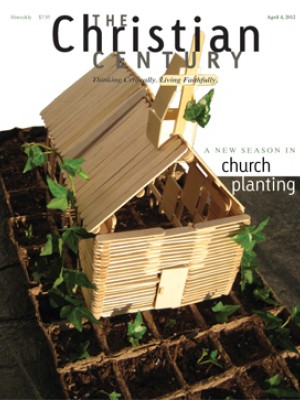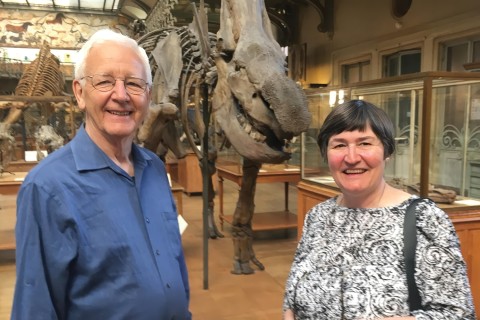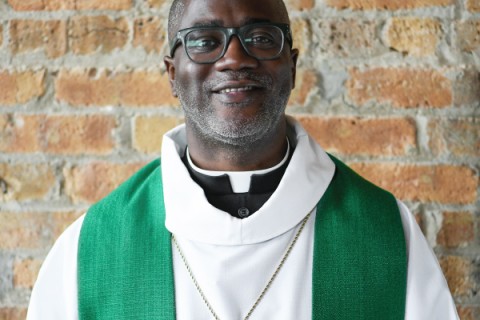New clergy, new churches: Church planting as a first call

Three years ago, Emily Scott had an idea. What if twentysomethings in Manhattan's East Village got together every Sunday for an agape feast, just as the early Christians did? Scott knew that Gen Xers and millennial peers crave egalitarian participation in a close-knit community and tend to avoid anything that looks like an institution. What if a group of friends cooked and ate a meal together, read scripture and sang some hymns? St. Lydia's, named for the hospitable woman mentioned in Acts 16, was born.
At first a dozen young adults met in each other's apartments, but soon Trinity Lower East Side Lutheran Parish adopted St. Lydia's. Trinity's sanctuary could accommodate dining tables, and Scott was given an office in the 175-year-old church building. When St. Lydia's grew in number to 20 people, both congregations agreed that St. Lydia's needed to work toward independence. The tiny congregation would either have to strike out on its own or affiliate with a denomination. It engaged in a nine-month discernment process with the Metropolitan New York Synod, part of the Evangelical Lutheran Church in America. The synod agreed to allow St. Lydia's to join and retain its identity, so the congregation decided to join.
Read our latest issue or browse back issues.
There was one problem: Emily Scott, though a graduate of Yale Divinity School, was not ordained (she is currently a candidate for ordination in the ELCA). In order for its feast to be a synod-sanctioned Eucharist, St. Lydia's needed to have an ordained person preside. (Various volunteer clergy had filled that role previously.) The ELCA also normally requires church planters to serve at least three years in an established congregation before embarking on new mission development. That would mean that if Scott wanted to lead St. Lydia's, she would have to leave and serve as a pastor elsewhere for three years. But the fledgling community was dependent on Scott's vision and pastoral care. "If I had been asked to serve three years in a parish," she said, "we would have failed."
Fortunately, the ELCA had just lifted the three-year requirement for church planters, allowing new seminary graduates to launch into church planting. Stephen Bouman, former bishop of the MNYS, had helped push for that change, which mirrors a movement across the mainline. Some denominations have even dropped the requirement that missioners be ordained before they serve and are supporting entrepreneurs who are building congregations among immigrants or young urban adults. These missioners have recognized a need and yearn to create a church to meet that need.
"Who is God's heart breaking for?" said Philip Lotspeich, coordinator for church growth in the Presbyterian Church (U.S.A.). "We've sensed that the way we've done church is not working in a lot of our communities. The people that [these young church planters] are reaching are just very different from those whom we would typically reach."
The Presbyterians have sent new seminary graduates to plant churches across the country, resulting, for example, in Sweaty Sheep, a ministry to runners and cyclists in Louisville, and Hot Metal Bridge, a church in Pittsburgh that opened in a tattoo parlor and then bought a vacant tavern. Other church plants reflect the New Monasticism movement, including a Presbyterian congregation in Pittsburgh, Lutheran missions in Austin and Seattle and a Methodist church in Nashville. Many of these churches are affiliated with intentional communities. The Episcopalians have a disco mass in San Francisco, a liturgy for the homeless on Boston Common, a church and community center for Latinos in Fort Lauderdale and the Art & Soul Café in St. Louis. All were started by recently ordained or not yet ordained ministers.
Carol Howard Merritt, pastor and author of Tribal Church: Ministering to the Missing Generation, applauds these initiatives. "As we head into a time of transition in all of our denominations, when a lot of our churches are closing, it's good to have a lot of energy going into starting new churches."
Many of these churches minister to students and young professionals who are revitalizing historically low-income neighborhoods. In Brooklyn, the ELCA is planting a ministry for young artists who are attracted to the Williamsburg and Greenpoint neighborhoods because of the ethnic diversity, relatively cheap rent and critical mass of like-minded hipsters. Ben McKelahan calls the ministry Sin Boldly Lutheran Laboratories. It's a mission sponsored by the MNYS and nearby ELCA and Episcopal congregations. McKelahan was motivated in part by his experience at Reed College in Portland, where he found that his friends were missing a sense of community, affirmation and purpose that his faith had given him.
"Some even hated church," he said. "I had to figure out how to create a safe, welcoming, interesting environment for them."
After he decided to become a pastor, McKelahan enrolled at Pacific Lutheran Theological Seminary in Berkeley, California. Pacific Lutheran and Luther Seminary in St. Paul are the only two ELCA seminaries that offer a concentration in church planting. McKelahan also received a grant from the Fund for Theological Education to visit and learn from U.S. arts organizations that use collaborative creativity to create community. Today he does large-scale art in public places: splashing big, colored soap bubbles on foam board to make random patterns, tying yarn in trees, attaching ink markers to remote-control cars and driving them across swaths of butcher paper.
"The art's not the point," McKelahan said. "When I'm running around the park chasing bubbles, people ask me what I'm doing. I ask them, 'You want to help?'"
Leading a community like McKelahan's requires particular gifts. Neither he nor the MNYS will officially name the ministry he's started; that's a decision that the community will make for itself, just as St. Lydia's had to wrestle with joining the ELCA. A church planter has to live with this ambiguity and risk, resisting the temptation to control outcomes. These new church planters have developed what MNYS staff member Jack Horner, referring to Emily Scott, calls a collaborative way of leadership.
Bishop Chris Boerger of the ELCA's Northwest Washington Synod describes an example of collaborative work led by church planter Ryan Marsh, who started the Church of the Beloved in Edmonds, Washington. Marsh has urged the artists in his congregation to think creatively about congregational worship. One Sunday when Boerger was preaching at the church, a poet shared a reflection on the lectionary text for the day. "She nailed the text more directly than I did in a traditional sermon," recalls Boerger.
Many seminaries have updated their curricula to focus on church planting. A new concentration in evangelism and justice at Pacific Lutheran teaches seminarians to collaborate with existing social justice agencies as a way of understanding and meeting community needs.
"The idea is to engage the kind of ministries that are already going on within the community and discern ways in which the church can partner with them," said PLTS admissions director Steve Churchill.
Pacific Lutheran emphasizes multiculturalism, religious pluralism and the public sphere in its curriculum, training students to understand specific neighborhoods and how to reach them with the gospel. At Princeton Theological Seminary, Darrell Guder is teaching "missional hermeneutics." Under a Lilly grant, he and colleagues and students are developing thick descriptions of worshiping communities to discern how their stories fit with God's story.
Some denominational officials believe that young pastors' inexperience can even be an advantage in responding to the needs of particular communities; they don't have a preconceived model of church. But that's not to say that young church planters don't have significant life experience. According to Guder, many of today's seminarians tend to be thirtysomethings in second careers. Their own process of vocational discernment helps them to help congregations discern their vocations.
Marsh, for example, before launching the Church of the Beloved, was a student at Seattle School of Theology and Psychology and assisted the church planter at Church of the Apostles, an Episcopal-Lutheran emerging church in Seattle. Two church planters in the ELCA's Saint Paul (Minnesota) Area Synod worked for years in youth ministry before they attended seminary. Paul Erickson, the synod's director of evangelical mission, sees this as valuable experience. He said "pipeliners"—students who go straight from college into seminary—often lack the self-awareness needed to succeed in collaborative ministry.
For his part, Episcopalian church planting specialist Tom Brackett thinks experience is crucial. "Our best church planters are in their sixties with 20 or 25 years of experience. They're doing a good job reaching out to younger generations and other ethnic groups. They tend to be very secure in themselves and have practiced the art of listening for what God is up to in communities."
Gary Shockley, new church strategist with the United Methodist Church, said that more and more of the denomination's lay missioners have spent time in vibrant congregations. "They know what it looks like and feels like, therefore they're more apt to be able to recreate it."
Church planting today is not all about reaching urban young people. Ruben Duran, the ELCA's director for development of new congregations, said that ethnic and socioeconomic minorities are also a major focus of outreach. The Saint Paul Area Synod has sent a first-call pastor to reach Chinese immigrants and another to lead Shobi's Table, which started as a medical ministry to the homeless at First Lutheran, the oldest Lutheran church in Minnesota. Seminarians who come out of their own ethnic communities are often the best candidates for going back to serve those communities.
"By adding more and more bars and hoops [to the creation of leaders]," said Duran, "we have been missing out on the opportunities to stay connected to the communities we are trying to serve. When we put the bar too high, it discourages people. We have the highest theologically trained leaders in the world, but then they need a few years to be human again and to be able to be with common people on the street."
Duran coleads Ecumenical Partners for Outreach, a group of church-planting officials from six denominations. They've found that seminary education is rarely one of the characteristics of successful church planters. Shockley of the UMC notes that more and more laypeople are starting Methodist churches and bypassing the usual ordination track—which consists of four years of college, three years of seminary and two years of probationary ministry.
"We're talking eight to ten years," said Shockley. "That's the system that's been in place, but it's not working across the board. . . . You can't teach a person vibrant personal faith in Christ. You can help them to deepen it, but you can't teach it. You can't teach somebody to have an entrepreneurial spirit. That's either there or it's not."
Seminaries like Luther in St. Paul are helping future church planters discern and develop their gifts. A new Congregational Mission and Leadership concentration option for Luther's M.Div. program magnifies a missional theme found throughout the curriculum. Courses required for all M.Div. students include reflections on local church context, and students learn social science research skills in order to help them understand particular communities.
Mary Sue Dreier oversees the new concentration at Luther. She said seminaries must train clergy to start new missions right after seminary because established congregations aren't equipped to reach growing new immigrant populations or even young middle-class white adults who grew up in the church.
"In the '70s we were trained well to pastor the church that existed," Dreier said. "Now we complain, 'Can't it be like it used to be?' No! The issue is how to move from our anxiety into that hopeful future, and I think this is one way to do that.
"There's a lot of energy for finding new ways to reach out to those folks we've failed. Starting a new church is not dramatically different from what we're all doing—bringing imagination to the church everywhere."
Guder said the church's decline has sparked interest in evangelism within mainline denominations. "If we don't talk about evangelism, our churches are really going to die. I don't think that infuses the curriculum of any mainline seminary. But I think it's beginning to."
At Pittsburgh Theological Seminary, Scott Sunquist said even faculty members who don't share his interest in church planting have embraced a new church-planting M.Div. concentration because it attracts students. Sunquist helped to develop the program because students were already planting churches and asking for more training. In the mid-'90s, he started a course on missionary theologian Lesslie Newbigin and the church in culture.
"We're not doing anything prophetic," Sunquist said. "We're doing what the Pentecostals, the Baptists and the Evangelical Covenant Church have been doing for the last 20 or 100 years. I'm afraid that most of the seminaries are not catching up."
Church-planting students at Pittsburgh Seminary begin their study with a two-week intensive course prior to the first semester, then complete certain designated courses in evangelism and leadership. Even more important, said Sunquist, is student missionary work in the community. One student, for example, works as a barista at a local coffee shop.
"He's working four or five hours a day [so that] he can meet people and invite them to Bible study," Sunquist said. "That'll keep you humble. [Seminaries] were making sure you were really well institutionalized, but in our postmodern world they've realized it's more important to help people participate in a movement."
Denominational officials are looking for people—whether enrolled in seminary or not—who are already community leaders. "Who's already doing this, and how do we bless them?" Tom Brackett asked. "We cannot find a correlation between seminary education and [the kind of] leadership that knows how to gather a thriving congregation."
According to Brackett, the Episcopal Church is reversing its mission development process: rather than training new clergy to plant churches, it finds people active in ministry (to the LGBTQ community in Boston, for example, or Latin American immigrants in Florida) and ordains them.
Like many successful new missions, St. Lydia's began without synodical support or funding. It began, notes Horner, when "a young passionate Christian woman [Scott] started talking with her friends." Leaders like Scott "can flourish in a situation where they have some freedom to experiment. They might not have that kind of freedom in an established congregation."
Of course, many of these new approaches to ministry only look new. St. Lydia's in Brooklyn and the Open Door in Pittsburgh are examples of new missions drawing on ancient monastic traditions.
"It's like first- and second-century traditional," said ELCA's Jack Horner.
"It's back to the early church," said Bishop Robert Rimbo.
Denominations must take risks with ventures like St. Lydia's, said Carol Howard Merritt, and be willing to try again and again when they fail.
"We're not really good at failing, and so we take failures very, very hard," she said. "We need to expect that out of two churches that are being started, one will be a sustainable, viable congregation in 20 years."
Duran agreed. "We have to try something, even if we are making mistakes here and there. We are at moment in history when communities are requesting more and more of these new ventures."





